Half a year ago, some former clients contacted me regarding Indy, their 18-month-old Australian Shepherd, asking if I could take him for boarding and training. The dad was about to leave the country for eight weeks, and the mom had her hands full with Indy, a challenging toddler, and a new baby.
Indy was what many consider a “hyperactive” dog, busy all the time and difficult to manage. My clients loved him, but found it exhausting to raise him.
Indy is one of the smartest dogs I’ve ever had the honor of caring for and training. It seems like he’s always thinking about what’s next, whether we are in the car, at home, or anywhere else. He’s thinking about how much fun he can have – and he wants to engage anyone near him to join him in his follies. But he’s not just anticipating; he also has a prodigious memory of places, events, and objects, and his memories trigger excitement anew.
Unfortunately, all of that energy, excitement, and anticipation ultimately resulted in a dog who was in a constant state of hyperarousal. He was reactive on leash and aggressive with dogs he didn’t know. He was constantly on the go and unable to focus in the face of any distractions. Worse, he started growling at the family’s toddler. The last straw for the family was when he bit the gardener, someone he was familiar with, while the gardener was operating a leaf blower.
He never seemed to tire, either. His guardians handed him over with the comment, “Good luck trying to wear him out.”
Does Exercise Help with Overarousal in Dogs?
There is a widespread notion that the ideal way to manage hyperactive dogs is to try to tire them out, with treadmills, endless games of fetch, paid dog-runners, and so forth. I tend to disagree. I think less is more when it comes to dogs like Indy.
It’s true that dogs like Australian Shepherds, a breed commonly referred to as “high drive” and thought of as “needing to work,” enjoy hard exercise. But while I believe that every dog benefits from having a job, I think less work is better for these especially smart, active, and sensitive individuals, particularly in their first three years. In my opinion, it’s far more valuable to teach dogs like this to settle themselves, instead of trying to physically exhaust them. And forget about employing the “forced settle” method – an oxymoron that leaves the dog no choice in the matter and often exacerbates the dog’s so-called hyperactivity.
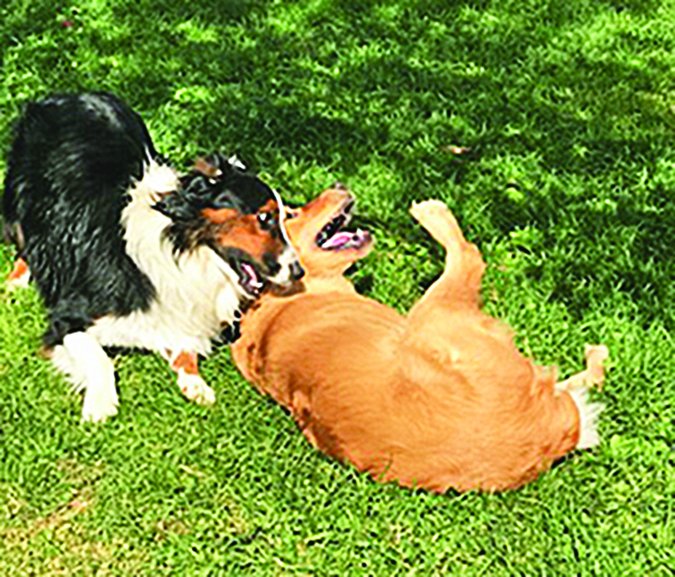
Some dogs get labeled as hyperactive as puppies; others, like Indy, get characterized this way in adolescence. Usually, guardians of energetic puppies and adolescents hope that their dogs will grow out of this hard-to-manage phase. In my experience, if these pups don’t have their needs met with appropriate training, exercise, and adequate rest, they grow into it, except with more size, endurance, and vigor.
The term “hyperactive” is commonly used today, but without much precision or understanding. I’d define it as abnormally or extremely active. Usually, when I meet a dog who is consistently referred to as hyperactive, what I see is a dog whose hyperactivity has advanced into a mode of hyperarousal – a physiologically aroused state characterized by heightened, overexcited reactions. Hyperarousal has nothing to do with sexuality; the state is more akin to a “fight or flight” mode. A dog who is in a state of hyperarousal often has little or no ability to calm himself down.
I believe that when hyperactive dogs don’t have their needs met, they often begin to present with behaviors typical of hyperarousal; they get overexcited when playing or greeting people or dogs (or just seeing them at a distance), and are unable to focus when triggered. Unfortunately, people often unintentionally reinforce these behaviors. When a dog paws at you, whines for attention, continuously drops toys in your lap, etc., it’s natural to pay attention to him, whether by getting frustrated and angry with his relentless pestering and yelling at him (or worse), or by petting him or throwing the toy for him.
The latter tactic is common; most of us have heard that the best way to deal with a high-energy dog is to exercise him very well and keep him highly stimulated. Right? Wrong!
When dogs engage in a physically demanding activity like playing fetch, hunting, herding, or even just playing hard at the dog park, their adrenaline and cortisol levels spike upward. Many dogs seem to find the continual release of these hormones enjoyable – the feeling may even be addictive. (And what do most of us do when faced with a “fetch addict”? We throw the ball or Frisbee for them!)
Hyperactive dogs aren’t born this way. Yes, genetics and breed must be taken into account, but if we teach them healthy, appropriate behaviors during puppyhood, we can help them grow into less anxious dogs.
Anxious? Yes. Remember, dogs who exhibit hyperarousal behaviors are in a constant or chronic state of physiological arousal, unable to settle, even when put in a crate for “down time.”
Crating the dog may give his handler a break, but if you let the dog out and he immediately goes back to his relentless shenanigans, you will see that the time in the crate (or forcing a “settle” on a mat or on his bed) hasn’t helped relieve his anxiety, it’s just squelched it temporarily.
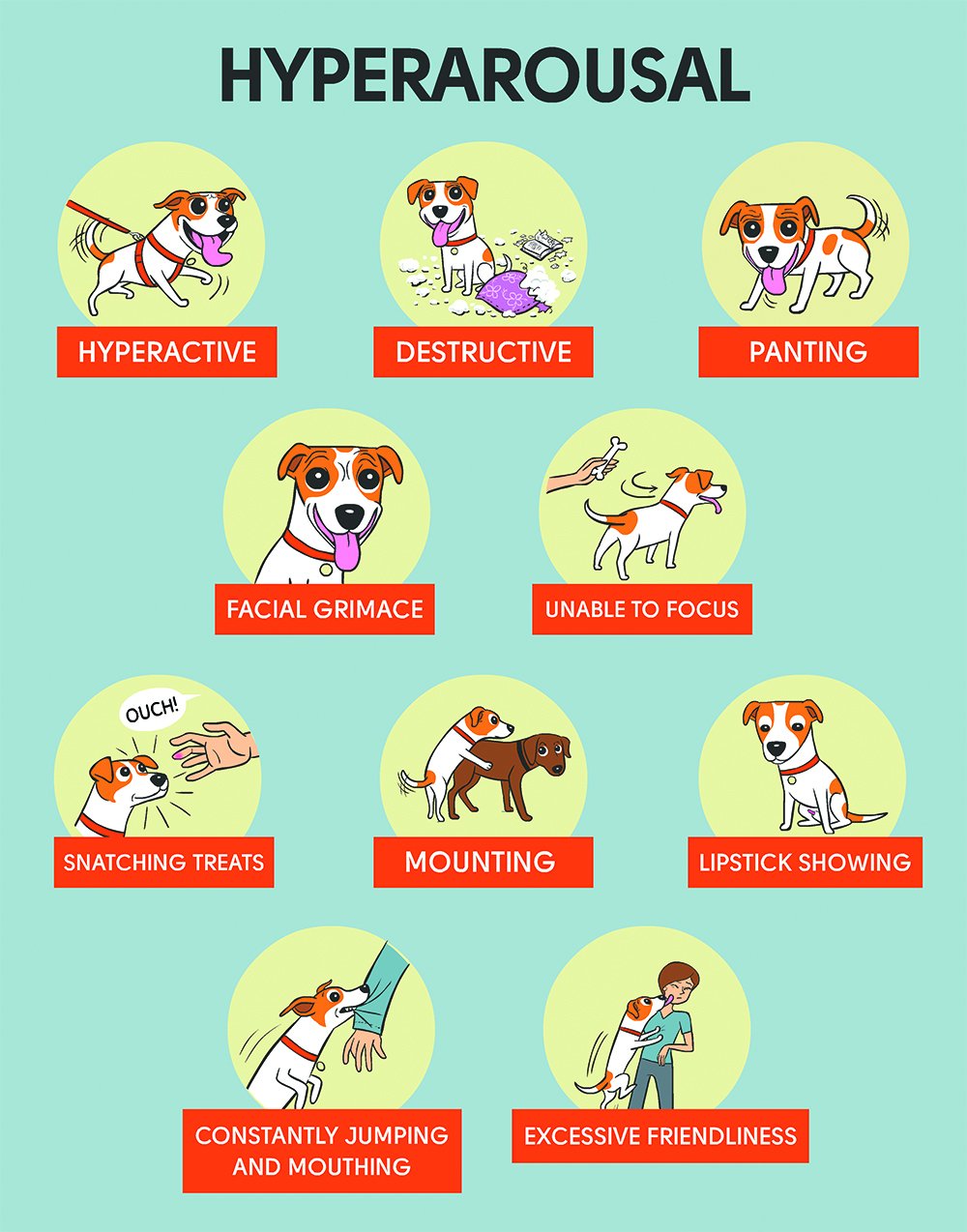
vetbehaviourteam.com
I observed that when I threw a flying disc for Indy to fetch – his favorite game – after about six throws, he was panting really hard. It became clear that the panting was due to stress and hyperarousal behavior, not tired from over exercise.
Indy’s guardians had done more to address Indy’s hyperactive behavior than many people might have. They taught him lots of good-manners behaviors and tricks, and gave him tons of exercise. They frequently took him hiking, and even arranged for him to herd sheep with a herding trainer (who also said he was the smartest dog she had worked with!).
I knew there was only a small window of time to turn things around with Indy. If he didn’t learn to feel less anxious physically and mentally by the time he reached maturity (about three years of age), there was a good chance he would bite again. But if I could find a way to relieve his anxiety, he stood a chance of leading a good life, not causing harm to any other person or dog. I agreed to take him for an extended period of boarding and training.
Hyperarousal Rehabilitation: Helping a Hyperactive Dog Calm Down
For the first few days, I didn’t do anything but allow Indy to adjust to his new environment while observing him and how he moves through his world. I wanted to see what got him excited and how he calmed himself – or if he could calm himself.
I watched how he responded to cues, my dogs, and me. I observed his eating, potty, and sleeping habits. He revealed more of who he is each day.
When Indy came to me, he was on a high-end commercial diet, and his stools were almost always too soft – an indicator of stress. I switched him over to a home-prepared raw-food diet and monitored his stool. Within about two weeks, his stool had firmed up nicely.
After four days of observation, I began some low-key training sessions with Indy, sometimes in a group with my other two dogs and sometimes with Indy alone. For the first three weeks, I limited the sessions to a maximum of five minutes apiece, about four times a day. During these first three weeks, we practiced tricks, obedience cues, and did agility exercises with agility equipment in my yard.
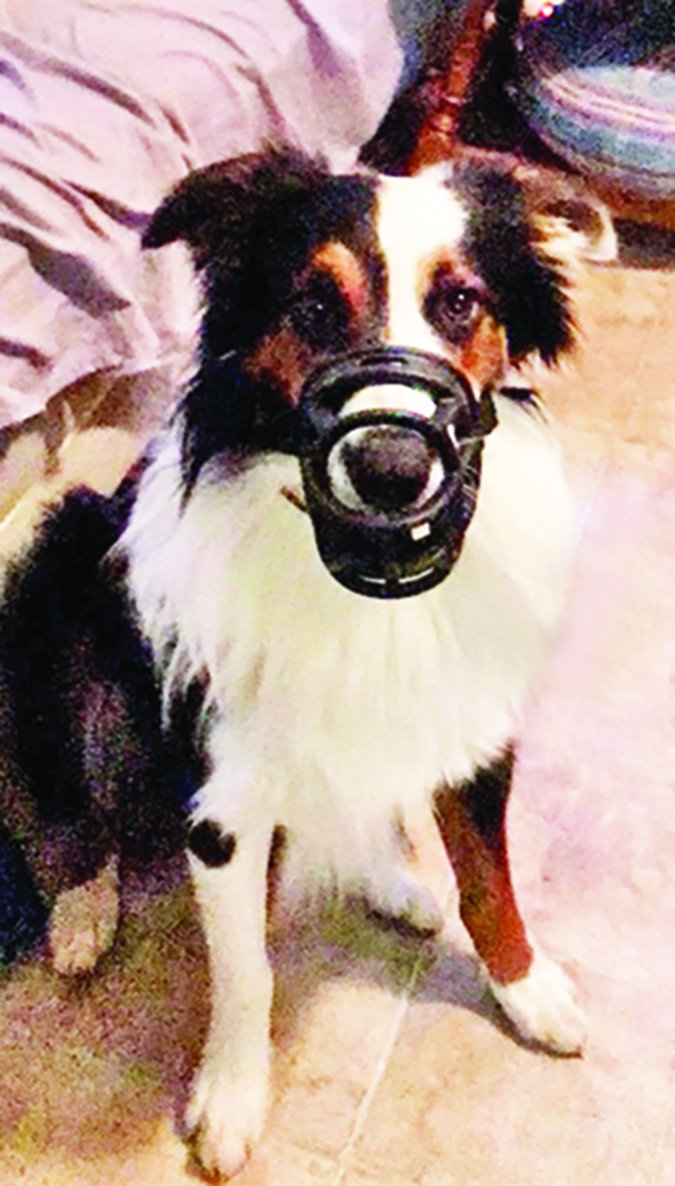
Because of Indy’s bite history, I also worked to accustom him to happily and comfortably wear a muzzle. Having a muzzle on him initially helped keep me relaxed when out in public and keep my other dogs safe, but after about two weeks, I felt it was no longer needed.
I gave Indy lots of enrichment activities during those first few weeks. I hid toys for him to find (scent games) and gave him food-stuffed puzzle toys to work on.
We played fetch with a flying disc – his favorite game – only once a day, and only for about five or six throws. I did not want him to have any opportunities to wind himself up into a state of hyperarousal.
When we weren’t interacting in one of these activities, Indy was free to do whatever he wanted – and at first, what he wanted to do most was try to engage me in all the ways his owners had complained about. Whatever he did, I ignored.
The first tactic he tried was to go to the door, asking to go out; if he was outside, he would bark or whine to be let back in. This was his way of trying to initiate play, fetching, and training. But as long as I knew that his needs had already been met – he had gone potty, had exercised, and had some attention and training – I did not let him in or out or engage with him in any way. It took him a couple of weeks to stop trying to engage me, dropping toys at my feet, whining for attention, aimlessly wandering around looking for something to do.
As annoying as all that activity was, I didn’t force him to settle anywhere. He had free roam of the areas where I was, in my home. There were toys, safe chews, and puzzle toys at his disposal, so it wasn’t like he didn’t have ways to entertain himself; he just never learned how. He only knew how to engage, not to settle on his own.
In the beginning, he would settle for a minute or two and then jump right back up and get right back to vying for attention. Eventually, he would settle for about five minutes before getting up and pacing around. I ignored him. The settle period grew to 15 minutes.
Within a month, he learned to rest peacefully without pestering me for anything. He finally started getting the rest that’s required for dogs of any age, especially puppies, and didn’t need to engage or be busy all the time.
Touch is a much needed and often overlooked part of caring for dogs. Cuddling is wonderful, but what I’m talking about is purposeful, loving touch, like massage or TTouch. When I started massaging Indy, he wasn’t sure what was happening and tried to engage in play by playfully biting my hands. But after about five minutes of low- energy massage, with no talking or eye contact, with me just paying focused attention to his body with a gentle, intentional touch, his eyes would soften, he would begin blinking, and we would both fall into a blissful state of complete relaxation.
As he was adjusting to his new life, I would massage him first thing in the morning, every evening, and in many short sessions throughout the day. At first Indy didn’t like to be brushed. After all this gentle massage and handling, when I take out the brush, he rolls over for it.
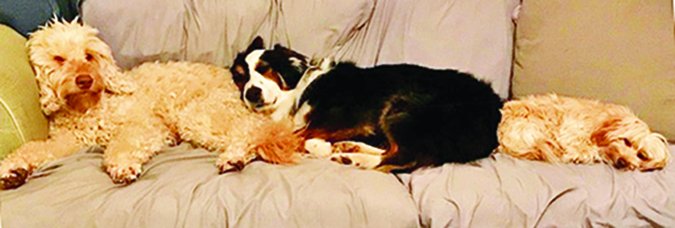
Next Phase
In a month’s time Indy had made great strides. But I knew him well enough at that point to believe that he might never fit into his first family very well. While his response to meeting people was much improved, he could still be startled by people who behaved unpredictably – and if there is anyone who behaves unpredictably, it’s a toddler who also has behavior issues. The family had enough challenges even without Indy in the home.
After a lengthy conversation, we all agreed that I would find another home for Indy when the time was right. The decision to let Indy go was not an easy one for this family, but they wanted what was best for him and realized that they couldn’t provide for his special needs at this juncture.
Reducing Indy’s high anxiety around leaf blowers was a significant accomplishment. Since Frisbee was his toy and game of choice, I used it to teach him that leaf blowers weren’t something to be afraid of and the people who handle them weren’t either. I would position a leaf blower in my yard, and throw the Frisbee a time or two. I would then turn the blower on and throw the Frisbee another time or two. If he remained calm, I’d pick up the blower and throw the flying disc a final time or two.
After a few weeks of this, he no longer reacted to the blower or me when I used it. Changing Indy’s association with the blower from fear and anxiety to indifference by playing Frisbee with him near the blower worked wonders.
Later, I invited a friend whom Indy hadn’t met to come and use the blower while I played Frisbee with Indy at a slight distance. I moved slowly and kept the game very calm to keep Indy from getting triggered and going “over threshold.” Don’t underestimate the power of play when working on changing behaviors! It worked exceedingly well.
When Rehoming a Dog Is Best
When we bring a dog into our lives and home, our goal is to have a lifelong partner. The thought of living without them is not something we want to consider. However, sometimes circumstances present things we never could have anticipated. Sometimes, it turns out that “the dog of our dreams” does not actually fit comfortably into our family; sometimes, our families are not right for our dog! As their advocates, at that point, we should try to do what’s best for the dog.
In considering what’s best, we need to try to honestly determine whether the dog is thriving, whether our family is thriving, or if we are all just scraping by in survival mode because we are afraid to admit our failure to successfully integrate the dog into our family.
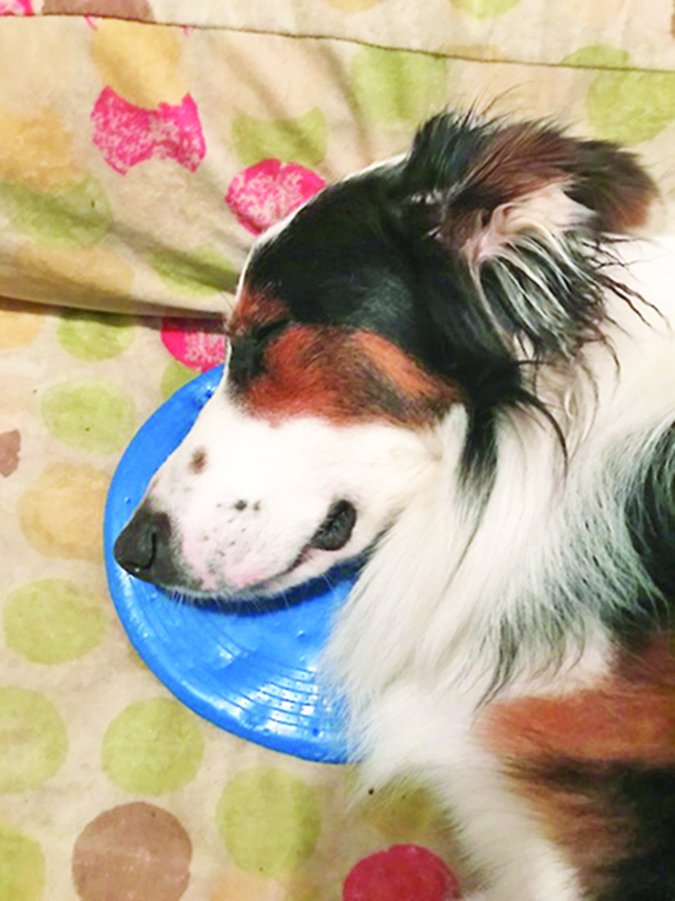
Making a commitment to the dogs we bring into our lives must be taken seriously, yet there are times when keeping a dog can be a big mistake for all involved. Guilt or feeling like a failure must never be a reason for keeping a dog when he may have a better opportunity to thrive, not just survive, in another family.
Love is unlimited. Rehoming a dog doesn’t mean we don’t love them; it actually means we love them so much that we want them to live the best life they can.
Indy’s Progress
I’ve had Indy for almost four months now. He is no longer reactive on leash or aggressive with other dogs or people while out and about. He can walk on a six-foot leash or a long line and has a near-perfect recall in the face of distractions. He will wait and watch dogs, people, bicyclists, or any of his past triggers without a reaction. And – you probably have already guessed – I’ve decided that his permanent home is with me.
I wholeheartedly agree that appropriate stimulation of mind and body is healthy for dogs. But I think it’s even more important for these hyperactive dogs to get a lot of uninterrupted rest and deep sleep during their first couple of years – with their guardians, not left in crates, pens, or tethered on mats. If we don’t allow a ton of time for rest with us, they never learn how to turn it off, by themselves or in our presence.
Indy is coming up to his second birthday. When he came to me, he exhibited seven of 11 behaviors that are classic symptoms of hyperarousal (see “Hyperarousal” graphic, above). I’m thrilled to say that, today, his formerly chronic anxiety is gone. He’s finally getting his needs met, with the adequate rest that’s required for dogs of any age, especially puppies, and doesn’t need to engage or be busy all the time. As he learned to rest on his own and enjoy the much-needed rest and deep sleep his body required, the unwanted hyperarousal behaviors began to subside and today, he doesn’t exhibit any of them.
Given his age, though, he’s still a work in progress. To maintain his emotional healing and well being, I will have to manage his environment and activities carefully, but it will be worth it, to spend time with this special dog and watch as he matures into a solid adult dog companion.
When Indy wants attention today, it looks much different than it used to. He’ll approach me quietly, staring at me until I look at him. If I reach out my hand, he will come close enough to be petted, calmly standing with a wiggly Aussie tail and butt and soft blinking eyes. Then, he will lay at my feet, resting peacefully.
Trainer Jill Breitner has been training dogs since 1978 and is a body-language expert. She is the developer of the Dog Decoder smartphone app, which helps people identify and “de-code” their dogs’ body language for a better understanding. She is also a certified Fear Free Professional and certified in Animal Behavior and Welfare. She lives on the west coast and does online training and consultations all over the world.







Thank you so much for this article! It was a wonderful read and I really loved the happy ending to all of this.
great article with a lovely ending!
Awesome read! Great information!!!
Lovely to read!
Just like the therapy you describe here, I have use for mye lovely “companion” Willow the dog – a Belgian Shepherd dog, a Groenendal -age 3. 5 years today. She responds to massages, instructions, touches, and today she responses and behaves in a way that makes her “fit” in all situations. At home – outdoor – visiting other homes etc. Despite her high energy level!
A true joy to have her around!
<3
Beautiful article. Very timely, as this will help greatly with my adolescent border collie. Much appreciation for sharing!
Hi thanks for sharing! I think I’m running into a similar situation with a current foster dog. Do you have suggestions for teaching a dog to learn to settle on her own, if she is destructive?
Excellent article! Lays out a journey I have trod with a very similar dog (also a male Aussie). But it took me a lot longer to get there! Thank you for chronicling this.
Thank you for this excellent article! This describes our current pup perfectly, except he will bite and jump to ensure he gets attention, and this behavior is almost impossible to just ignore. I can ignore the pacing or throwing toys in my lap, but when he would rather gnaw on my arm or try to jump and nip in my face than engage with his kong, I have to stop him. Do you have any tips for correcting this kind of attention seeking and getting him to settle?
What a lovely article. Having a german shorthaired pointer from working lines our gundog trainer said that i need to give him time out to rest because he would just go on and on. He was harden as a puppy as he didnt like sleeping much as a puppy. Time out after coming back from being on a walk or any training helps him wind down nowadays.
Thank you for this article, it helped explain a lot of hyperarousal in dogs and how to help them relax. I am curious if Indy relaxed at all his triggers because he was over all more relaxed or if you had to work on each of those triggers individually like the blower? Thanks!
Lovely interesting read.. my dog is calm at home but is aware of delivery Van’s and is an absolute nightmare when people come to the house especially when my husband comes home …. he is generally a pleasure to live with but as soon as we go walk in the road he is over aroused looking for cats … not reactive to people cars other dogs etc just the environment and smells which is challenging as I can t see or smell …. off lead his recall is variable I would never let him off near a road I have worked so hard on proximity games counter conditionning building his confidence and giving him plenty of enrichment such as kongs licky mats … ditched the routine I am sure he is Jekyll and hyde calm generally at home outside lunatic … not interested in toys outside the home very food orientated …. any tips
Hello,
thank you for sharing this. I think I have done exactly what you say shouldn’t be done to my border collie. I have becommon dog entertainer… I was so affraid she’d be destructive otherwise…On the top of everything she’s ill socialized due to Covid restrictions in Canada. Thankfully she’s still very young and reparable. Thank you!!!
thank you for this great article. Can u plz elaborate on how to get such dogs to rest/sleep in their owners presence ,though, at our feet or nearby? Unless he is exhausted from playing hard, he usually won’t calm down and sleep near us much, but we are busy and don’t just lay around watching tv either, but we would do more of that if he would lay down and rest, too!!!
This article is just what I’ve been looking for!! Our German Shepherd is 1yr old this week and always ‘on watch’ and highly aroused.
The last few weeks I have been trying to leave him to be calm on his own, so very few walks and little play. It’s definitely a work in progress but so worth the outcome. I need to do more mental enrichment throughout the day as you’ve stated so I need to get a plan in place!! Thank you again!!
Oh my – this is my dog – but a slightly toned down version (she still has 5 of these behaviors – we’ve conquered 3, and she never exhibited mounting or lipstick, obviously). I just kept describing her as “over-exuberant.” Her tail wags non-stop. She sees dogs on our walks & people invariably bring their dog over – she does a spastic play bow & then both dogs are hyped! I’m now switching routes because I can’t seem to get through to folks that I don’t want to do a meet & greet with every dog. I have puzzles, we only take 1 walk a day, I’m doing training & scent games, BUT I’ve been throwing her fav toy too long & giving in to her constant interruptions (this is an epiphany!). And I do the massage – just need to do more! Thank you for rocking my world & giving me new hope to focus on. She is resting calmly by my bed…that is soooo important (she’s only 2 years old). She’s a very smart scent hound / sight hound mix (my Vet was quite impressed with her & said “she’ll be easy to train.” I got her through separation anxiety, and that was a big win (she’s a rescue dog, so you never know what you’re getting into). So, a heartfelt THANK YOU from me for your brilliant article. I’m in awe of your talent!
This was very informative and helpful. I came across your article while trying to find ways to best train our husky/Australian cattle dog mix we adopted from the shelter at six months old. At eight months she is still not anywhere closer to potty trained than she was when we brought her home.
She also definitely exhibits many of the signs of a hyperaroused puppy. Do you have any tips to best potty train an adolescent pup who I’m guessing was never trained early and is constantly distracted and excited? She has a tough time ever just sitting still and relaxed. I know she is at a great age still to correct her habits but we just really want to get her potty trained before we focus on other skills. She is smart and picks up tricks easy but again, constantly begs for attention but jumping, nipping, whining, wanting to play tug of war or fetch and getting what we cal the “zoomies” running around both inside and outside.